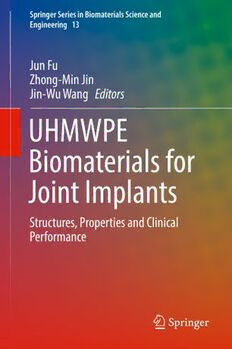
UHMWPE Biomaterials for Joint Implants: Structures, Properties and Clinical Performance PDF
Preview UHMWPE Biomaterials for Joint Implants: Structures, Properties and Clinical Performance
Springer Series in Biomaterials Science and Engineering 13 Jun Fu Zhong-Min Jin Jin-Wu Wang Editors UHMWPE Biomaterials for Joint Implants Structures, Properties and Clinical Performance Springer Series in Biomaterials Science and Engineering Volume 13 Series editor Prof. Min Wang Department of Mechanical Engineering The University of Hong Kong Pokfulam Road, Hong Kong e-mail: [email protected] Aimsandscope The Springer Series in Biomaterials Science and Engineering addresses the manu- facture,structureandproperties,andapplicationsofmaterialsthatareincontactwith biological systems, temporarily or permanently. It deals with many aspects of modern biomaterials, from basic science to clinical applications, as well as host responses.Itcoversthewholespectrumofbiomaterials–polymers,metals,glasses and ceramics, and composites/hybrids – and includes both biological materials (collagen, polysaccharides, biological apatites, etc.) and synthetic materials. The materials can be in different forms: single crystals, polycrystalline materials, parti- cles, fibers/wires, coatings, non-porous materials, porous scaffolds, etc. New and developing areas of biomaterials, such as nano-biomaterials and diagnostic and therapeutic nanodevices, are also focuses in this series. Advanced analytical tech- niques that are applicable in R & D and theoretical methods and analyses for biomaterials are also important topics. Frontiers in nanomedicine, regenerative medicineandotherrapidlyadvancingareascallingforgreatexplorationsarehighly relevant. The Springer Series in Biomaterials Science and Engineering aims to provide critical reviews of important subjects in the field, publish new discoveries and significant progresses that have been made in both biomaterials development and theadvancementofprinciples,theoriesanddesigns,andreportcutting-edgeresearch and relevant technologies. The individual volumes in the series are thematic. The goalofeachvolumeistogivereadersacomprehensiveoverviewofanareawhere newknowledgehasbeengainedandinsightsmade.Significanttopicsintheareaare dealt within good depth andfuture directions arepredicted on thebasis ofcurrent developments. As a collection, the series provides authoritative works to a wide audienceinacademia,theresearchcommunity,andindustry. Moreinformationaboutthisseriesathttp://www.springer.com/series/10955 (cid:129) (cid:129) Jun Fu Zhong-Min Jin Jin-Wu Wang Editors UHMWPE Biomaterials for Joint Implants Structures, Properties and Clinical Performance Editors JunFu Zhong-MinJin NingboInstituteofMaterials TribologyResearchInstitute,Schoolof Technology&Engineering MechanicalEngineering ChineseAcademyofSciences SouthwestJiaotongUniversity Ningbo,Zhejiang,China Chengdu,Sichuan,China Jin-WuWang ShanghaiKeyLaboratory ofOrthopaedicImplants DepartmentofOrthopaedicSurgery ShanghaiNinthPeople’sHospital ShanghaiJiaotongUniversity SchoolofMedicine Shanghai,China ISSN2195-0644 ISSN2195-0652 (electronic) SpringerSeriesinBiomaterialsScienceandEngineering ISBN978-981-13-6923-0 ISBN978-981-13-6924-7 (eBook) https://doi.org/10.1007/978-981-13-6924-7 ©SpringerScience+BusinessMediaSingapore2019 Thisworkissubjecttocopyright.AllrightsarereservedbythePublisher,whetherthewholeorpartofthe materialisconcerned,specificallytherightsoftranslation,reprinting,reuseofillustrations,recitation, broadcasting,reproductiononmicrofilmsorinanyotherphysicalway,andtransmissionorinformation storageandretrieval,electronicadaptation,computersoftware,orbysimilarordissimilarmethodology nowknownorhereafterdeveloped. Theuseofgeneraldescriptivenames,registerednames,trademarks,servicemarks,etc.inthispublication doesnotimply,evenintheabsenceofaspecificstatement,thatsuchnamesareexemptfromtherelevant protectivelawsandregulationsandthereforefreeforgeneraluse. The publisher, the authors, and the editorsare safeto assume that the adviceand informationin this bookarebelievedtobetrueandaccurateatthedateofpublication.Neitherthepublishernortheauthorsor theeditorsgiveawarranty,expressorimplied,withrespecttothematerialcontainedhereinorforany errorsoromissionsthatmayhavebeenmade.Thepublisherremainsneutralwithregardtojurisdictional claimsinpublishedmapsandinstitutionalaffiliations. ThisSpringerimprintispublishedbytheregisteredcompanySpringerNatureSingaporePteLtd. The registered company address is: 152 Beach Road, #21-01/04 Gateway East, Singapore 189721, Singapore Preface Joint arthroplasty has been the clinical choice to restore the function of malfunctioningjoints.Artificialjointprosthesisisusedtoreplacethediseasedjoints. In the components of contemporary joint implants, the articulating surfaces have been widely recognized critical for the in vivo performance and longevity of the prosthesis. The articulating surface configurations can be classified as metal-on- metal, ceramic-on-ceramic, metal-on-polyethylene, or ceramic-on-polyethylene. Here, the polyethylene is referred to medical-grade ultrahigh molecular weight polyethylene, or UHMWPE, with the average molecular weight over 1,500,000 g per mole. UHMWPE is advantageous over most other materials for its excellent biocompatibility, bioinertness, chemical resistance, high strength and toughness, low coefficient of friction, and low wear, which are desired for artificial joints. It has been the material of choice for both hip and knee since the early 1960s, when JohnCharnleyfirstintroducedUHMWPEtomanufacturethearticularlinersforhip prosthesis. Theaimofthisbookistogiveageneralandcomprehensiveintroductiontothe fundamental of UHMWPE as biomaterials for joint implants, major challenges of UHMWPEcomponentinhistory,andthemostimportantrecentprogressesofhigh- performance UHMWPE. The chemistry, physics, and mechanisms of the strength, toughness, wear, oxidation, and stabilization are discussed in detail. Moreover, biomechanicsandbiotribologyofartificialprosthesisareintroduced.Italsopresents clinical diagnostic methods to analyze the in vivo performance and to diagnose or predictthefailureoftheprosthesis. In history, UHMWPE implants have experienced very bad problems in clinical use. The cyclic articulating of femoral head against the UHMWPE liner produces numerous wear debris that migrate to the surrounding tissue and cause osteolysis. Moreover, early sterilization by gamma has made it even worse. The free radicals generated during radiation sterilization cause cascade oxidation of polyethylene on-shelf and in vivo, whichseverely deteriorates thestrength and toughnessofthe polymer and accelerates wear and failure of implants. In the 1980s, wear-related problemsarereportedtoaccountforalargeamountoftherevisionalsurgeries. v vi Preface Thebaddemandofwear-resistantmaterialshasstimulatedextensiveinnovations toimprove thewearresistanceofUHMWPE.Inthe1990s, diverse strategies have been developed to reduce the wear rate. Based on the wear mechanism that poly- ethylene fibers are generated due to plastic flow and fractured upon cyclic shear, cross-linking of the polymer chains is proposed to reduce wear by counteracting against the mechanism. High-dose radiation cross-linking has been successfully used to reduce the wear rate of polyethylene by 90% or more. Highly cross-linked UHMWPEhasbeenapprovedforclinicalapplicationsin1998.Sincethen,millions of joint implants based on highly cross-linked UHMWPE have been implanted in patients. The 20-year clinical outcomes have become very positive. Wear-related revisional surgeries have been largely reduced according to multicenter follow-up studies. Oxidationofhighlycross-linkedUHMWPEremainsachallengeforbothinvivo service and on-shelf behavior. This book will introduce some recent progresses on the use of very potent antioxidants, i.e., natural polyphenols, to stabilize highly cross-linked UHMWPE, which show outstanding strength, toughness, oxidation resistance, and low wear rate in comparison to the first-generation highly cross- linked UHMWPE. The oxidation and antioxidation mechanisms will be analyzed anddiscussedindetail. The success of UHMWPE in joint implants would not be possible without the developmentofbiomechanicsandbiotribologyofjoints.Thedailygaitingcontains sophisticated biomechanics and tribology that can never be described by using a simplemodel.Thisbookintroducessomefundamentalsandrecentprogressonthe biomechanicsandtribologyoftotalhipandkneeimplants. The clinical performance of the permanent joint prosthesis has to be regularly monitored to evaluate their in vivo status and predict any possible problems. Objective assessment methods based on medical imaging have been widely devel- oped and clinically used. This book will introduce the use of Roentgen stereophotogrammetricanalysistechniquetodetectthelooseningofhipprosthesis. ThisbookaimstoofferstudentswithfundamentalknowledgeonUHMWPEas biomaterials. Senior biomedical engineers, polymer scientists, joint implant pro- fessionals,andphysicianswillfindin-depthdetailsontheresearchmethods,exper- iments,andlatestprogressonUHMWPEmaterials. Itwouldnotbepossibletoaccomplishthisbookwithouttheoutstandingcontri- butions from the coeditors, Professor Zhong-Min Jin, and Professor Jin-Wu Wang andtheirteams.Iamverygratefultotheauthorsforwritingtheimportantchapters. ProfessorLuigiCostafromTurinUniversityisalongtimefriendandalwaysbrings newideas,particularlyontheoxidationandantioxidationmechanisms.Hisexpertise onFTIRspectroscopydefinitelybenefitsmeandmystudents.ProfessorShuxinQu has made great contributions to the UHMWPE biomaterials by introducing drugs into the polymer to depress osteolysis since wear is inevitable so far. I’m also indebted to Professor Ebru Oral and Professor Orhun K. Muratoglu who were my advisors during my stay in the Harris Orthopaedics Laboratory at Massachusetts GeneralHospital. Preface vii Finally,Iwouldliketothankmyteammemberswhohelpmealotinthechapter writingandexperimentsonUHMWPEbiomaterials. Ningbo,China JunFu December2018 Contents 1 ClinicalApplicationsofUHMWPEinJointImplants............. 1 JingChen,GuorongGao,andJunFu 2 HighlyCrosslinkedUHMWPEforJointImplants................ 21 GuorongGaoandJunFu 3 OxidationinProstheticUHMWPE.............................. 69 L.Costa 4 NaturalPolyphenol-StabilizedHighlyCross-LinkedUHMWPE forJointImplants.............................................. 93 JunFu 5 High-TemperatureMelted,Cross-Linked,andStabilized UltrahighMolecularWeightPolyethylene........................ 115 JunFu,EbruOral,andOrhunK.Muratoglu 6 Drug-LoadedUHMWPEtoInhibitWearParticle-Induced Osteolysis:Processing,Characterization,andBiological Evaluation..................................................... 151 ShuxinQu,YumeiLiu,andKemengGong 7 BiomechanicsandTribologyofArtificialKneeJoint.............. 191 ZhenxianChen,JingZhang,XiaoZhang,andZhong-MinJin 8 BiomechanicsandBiotribologyofUHMWPEArtificial HipJoints...................................................... 241 YongchangGaoandZhong-MinJin ix x Contents 9 ClinicalApplicationofRoentgenStereophotogrammetric AnalysisTechniquetoDetectHipAsepticLoosening.............. 287 Jin-WuWang,Yuan-JingXu,HanYang,andKe-RongDai 10 WearandDiagnosticAnalysisofClinicalFailures ofArtificialHipJoints.......................................... 317 Jin-WuWang,HanYang,Cheng-TaoWang,Zhong-MinJin, andKe-RongDai
